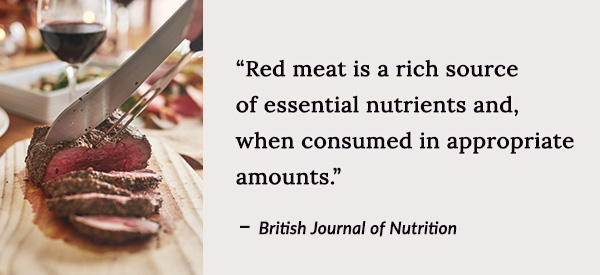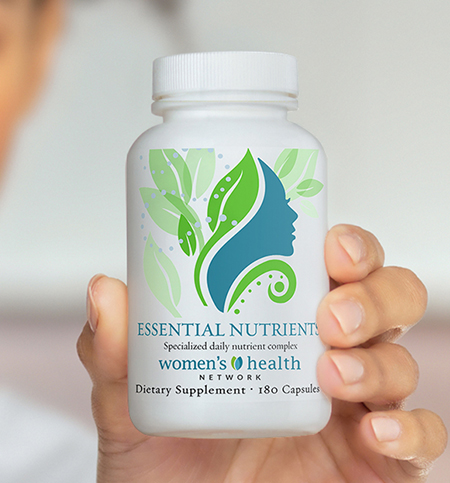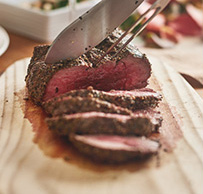Authored by Caroline Morin, NBC-HWC
If you’ve been confused about whether red meat is healthy or harmful, you’re not alone. One expert blames it for heart disease, and the next celebrates it as a nutrient dense superfood.

Nutrition science is still a relatively young field. It involves complex, living humans with different genes, habits and health histories which makes it notoriously hard to study. To complicate things further, most nutrition research has been done on men — leaving a major gap in how findings apply to women with our different hormone patterns, metabolic needs and reproductive stages.
One of the most important things to understand about nutrition — especially with something as debated as red meat — is that there is no single “right” answer for everyone.
So, how do you find what’s right for you? It starts with asking the right questions.
Is all red meat the same?
“Red meat” is a broad term that encompasses everything from a drive-thru burger to a grass-fed steak from a local farm. But nutritionally speaking, these are two very different foods.
A typical fast food burger is highly processed food, usually made from low-quality cuts, preservatives and additives/fillers, and is often cooked in ways that produce inflammatory compounds. On the other hand, high-quality meat — like pasture-raised lamb or grass-fed beef or bison from a locally sourced regenerative farm — is more nutrient-dense and contains:
- a better ratio of omega-3s to omega-6s,
- No added hormones or unnecessary antibiotics,
- and more nutrients that support muscle, immunity and brain function.
It’s like comparing a convenience store donut to a slice of homemade sourdough! Same category — completely different nutrition profile.
Can red meat be good for you?
Yes — when it’s high quality and consumed as part of a balanced diet. It provides several nutrients that are harder to get or less bioavailable from plant-based foods:
- Heme iron, the most absorbable form of iron (especially important for women who are menstruating, pregnant or trying to conceive)
- Complete amino acids to support muscle, hormones and immune health
- Vitamin B12, essential for brain function and energy
- Zinc, selenium and creatine, all critical for metabolism and recovery
- Collagen, essential for skin and connective tissue, is found in red meat, particularly tougher cuts and ground beef.
Of course, red meat isn’t the only way to get these nutrients — but it can be an efficient one for many women, especially those with higher protein needs, heavy periods or nutrient absorption issues.
How it’s prepared matters, too. A high-quality steak served with fiber-rich vegetables and complex carbohydrates creates a different metabolic effect than eating a fast food combo meal.
Red meat isn’t perfect. But it isn’t inherently dangerous, either. It’s a food — one that offers a lot of value when chosen and consumed with intention.
Is red meat right for me?
Instead of asking, “Is red meat good or bad?” — better questions might be: “How does it make me feel? Do I digest it well? Do I feel energized, strong and satisfied when I eat it? And how does it fit into the bigger picture of my health?”
Your response to red meat (or any food) is shaped by:
- Your gut microbiome, which helps process nutrients and influences inflammation.
- Your genetics, which impact fat metabolism and nutrient processing. This means two people could eat the same steak and have very different responses.
- Your heritage, which can shape how your body has adapted to certain foods.
- Your diet and health history will determine how your body responds. The same goes if you’re dealing with insulin resistance, anemia or autoimmune conditions.
- Your lifestyle. Are you training regularly? Struggling with sleep? Managing stress? All of these factors impact how your body processes food, including protein and fat. For someone building muscle or recovering from illness, a well-sourced cut of red meat could be deeply nourishing. For someone sedentary and eating a highly processed diet overall, it might not be the best fit.
So… should you eat red meat?
Instead of approaching it with an all-or-nothing mindset, try reframing the question. Not “Should I eat red meat?” but “Does it support me?” “If so, what kind? How much? How often?”
If you choose to include red meat in your diet, here are a few ways to make it work for you:
- Prioritize quality. Grass-fed, pasture-raised and regenerative-farmed meats are more nutrient-rich and environmentally conscious.
- Watch your portion. Most people don’t need a 16-ounce ribeye. A palm-sized serving (about 3–5 oz) is often enough.
- Balance your plate. Pair red meat with a few serving of colorful vegetables and a complex carbohydrate like sweet potato or farro to help buffer blood sugar, support digestion and reduce inflammation.
- Listen to your body. Pay attention to how you feel after eating red meat. Energized? Heavy? Satisfied? Bloated? Your body’s feedback is valuable, and it may shift over time depending on your hormone status, stress levels and nutrient needs.
- Don’t let food become a moral issue. Choosing — or not choosing — red meat isn’t a character test. What matters most is how your choices align with your values, your body’s needs and your long-term health goals.
The bottom line
Red meat has been one of the most controversial foods in the nutrition world for decades.
Yes, some studies have linked high red meat intake to certain health risks, but more recent and higher-quality research is challenging those conclusions, especially when it comes to unprocessed, high-quality meat consumed as part of an overall healthy diet and lifestyle.
The truth is: nutrition is nuanced, and so are you.
As always, the best approach is personalized. Choose what aligns with your values, supports your health and fits your life — not what the loudest headline is shouting.
And yes, you’re allowed to change your mind, evolve your habits and eat food that makes you feel good. That’s the kind of “diet” that actually lasts.
















